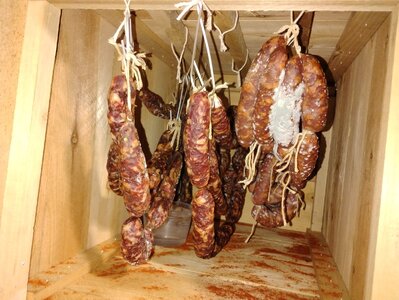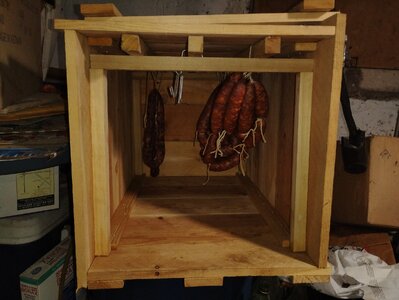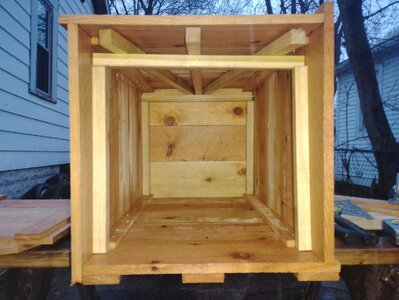- Apr 22, 2025
- 31
- 26
Built a "Ham Box" out of Cedar. It sits in the basement like a cigar humidor for meat. This is my low tech curing chamber solution.
Looking to have slightly higher humidity inside the box to slow down the drying of my mini salamis and encourage mold growth.
I ferment a lot of sauerkraut and pickles down there so I wanted to capture what was already living down there. Everyone loves their own brand, am I right?
Basement temp is around 50-60 degrees and about 60% relative humidity....ish.
I figured the wood would hold on to the funk, and act like a sponge when moistened to keep the humidity higher inside the box. It might even stay a few degrees cooler in there from evaporative cooling.
I hate the idea of corking things up in a plastic box....yuck. Does everything have to be plastic, plastic, plastic? Lol.
Captured some mold growth, gonna see how it turns out. So far so good. It smells like cheese when I open the lid, so that's cool.
Tried a few pieces of salami, happy with it so far.
Wanted to share the idea. So if someone is looking for the dirt-bag option for salami curing, you might give this a try. I'm not saying it's a great idea...it's just an idea.
Keeping things a little more humid and allowing the funk a place to call home.
A Hope Chest for secret meat!
-keep it secret, keep it safe!
Looking to have slightly higher humidity inside the box to slow down the drying of my mini salamis and encourage mold growth.
I ferment a lot of sauerkraut and pickles down there so I wanted to capture what was already living down there. Everyone loves their own brand, am I right?
Basement temp is around 50-60 degrees and about 60% relative humidity....ish.
I figured the wood would hold on to the funk, and act like a sponge when moistened to keep the humidity higher inside the box. It might even stay a few degrees cooler in there from evaporative cooling.
I hate the idea of corking things up in a plastic box....yuck. Does everything have to be plastic, plastic, plastic? Lol.
Captured some mold growth, gonna see how it turns out. So far so good. It smells like cheese when I open the lid, so that's cool.
Tried a few pieces of salami, happy with it so far.
Wanted to share the idea. So if someone is looking for the dirt-bag option for salami curing, you might give this a try. I'm not saying it's a great idea...it's just an idea.
Keeping things a little more humid and allowing the funk a place to call home.
A Hope Chest for secret meat!
-keep it secret, keep it safe!











